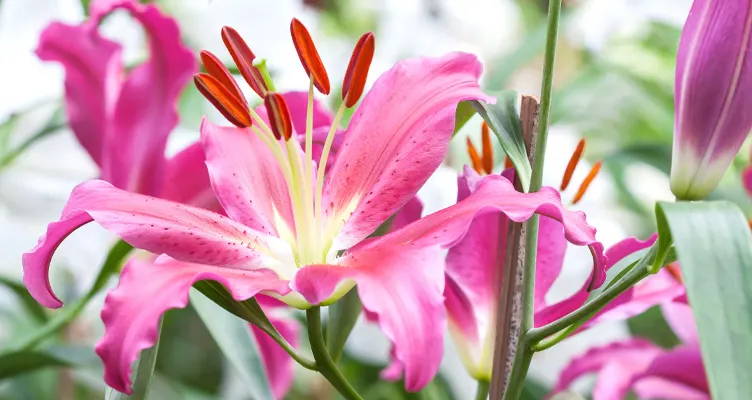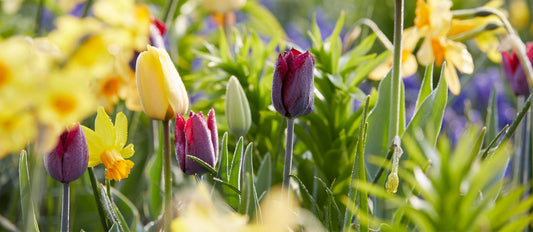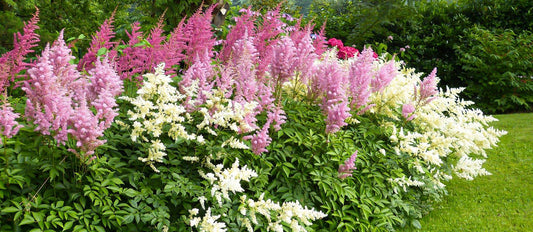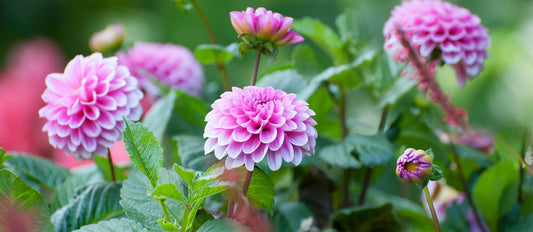Lilies are wonderful flowers that are also regarded as the symbol of the beauty of nature. The popular lily (Lilium) can be combined perfectly with other flower bulbs and garden plants. Lilies are planted them in autumn or spring for a profusion of flowers in summer!
Lilies: the beauty of nature
There are more than a hundred different varieties of lily and many more hybrids. The four main groups of hybrids are the Asian group, the Oriental group, the Longiflorum group and the LA group (hybrids of Asian and Longiflorum lilies). In addition a few varieties of lily grow in the wild in parts of Asia, America and Europe.
All lilies have three inner and three outer petals that taper slightly to a point. There are six stamens in the centre of the flower, between the petals. The flowers can have a diameter of up to 25 cm. The colour, exact shape and size all depend on the variety and size of the bulb.
- As its name suggests, the trumpet lily (Lilium Aurelian Group) has trumpet-like flowers that are shaped like a cup. Their magnificent white, yellow or pink flowers appear in June and July. Each stem can produce between 6 and 15 flowers.
- The Madonna lily (Lilium candidum) is known for its white flowers and is one of the oldest cultivated varieties of lily. This lily can grow up to 1.80 metres tall. It also supports more flowers on each stem than other lilies; up to 20.
- Tiger lily (Lilium lancifolium) flowers are a magnificent orange. Unique to this lily is that its petals curve completely back on themselves and its stamens protrude forwards out of the flower. There are many other unusual varieties of lily.
You will find them all in our range of lilies.
Planting lilies in the garden
Lilies are summer-flowering bulbs that display their colours in June and July. Plant them in autumn, between October and December, or in spring before April. But do make sure that you don't plant them during the frosts. Freezing temperatures could kill the bulbs. It is still recommend that you put lilies in the ground as soon as possible. The earlier you plant them, the longer they have to root and the stronger they will become due to the lower temperatures. This will ultimately produce plants that are stronger and grow taller with larger flowers.
Lilies like plenty of sun as long as their feet are cool. So, plant the bulbs in a spot with plenty of sunlight that you can cover over if necessary. Make sure that the soil is always slightly damp. The ground must be well aerated and drained so the bulbs can grow properly. Mix the soil with fresh potting soil or fertiliser to improve its quality. Be sure that you read the packaging before planting. Some varieties can tolerate chalky soil well, while others can't. If you aren't sure, then choose a slightly acidic soil. All lilies will grow well in this type of soil. A pH test will tell you how acidic your soil is.
Use a handy trowel or a special bulb planter to plant the bulbs. Dig a hole that is three times as deep as the height of the lily bulb and position each one with its pointed end facing upwards and its roots downwards. Place them around 20 to 25 cm apart. If you are covering a large surface area, dig a big hole first and plant all the lily bulbs at the same time. Fill the hole in with potting soil for flower bulbs and tamp down gently. If the soil feels very dry, give it a bit of water. Generally speaking, lily bulbs can handle cold weather. However, it is best to protect them with bubble wrap in extremely cold temperatures, rainfall or in strong winds.
Planting lilies in a pot
Lilies also look wonderful in a large flower pot on your patio or balcony, as well as in the open ground. Planting them is a doddle. Just follow these steps:
- Choose a large flower pot and make sure that it has small holes in the bottom, so excess water can drain away properly.
- Place a few pot shards in the bottom and fill the pot with fresh potting soil.
- Plant the flower bulbs around three times as deep as the height of the bulb with their pointed end facing upwards.
- They don't need as much room in a flower pot, so spacing them around 15 to 20 cm apart is fine.
- Top up with potting soil and tamp the soil down lightly.
- Water the lilies in the pot straight away.
- Put the flower pot in a sunny spot on your patio or balcony.
Mixing lilies to create a wow effect
Gardens and containers look even more attractive if they contain a mixture of colours and different flower and leaf shapes. Striking lily flowers are wonderful planted in a group. But you can also combine them with other plants in your garden to create a real wow effect. Lilies are the perfect companions for other tall flowering plants like gladioli, agapanthus, lupines and dahlias. Are you looking to create a natural and relaxed feel in your garden? Then choose a variety of flowers in two or three different colours and mix them together. Up for a splashier flower statement? Use even more varieties of shapes and colours. The more colours, the better! The rule of (green) thumb is true here, too: lilies can be combined with a wide variety of other flowers. There really is no way you can go wrong.
Bringing lilies indoors
Lilies are perfect as cut flowers indoors. Simply snip a few flowers from your garden and put them in a vase with some foliage. Make sure that the vase is clean and cut the stems at an angle. Remove the lower leaves to stop them hanging in the water. Depending on the indoor temperature, the lilies can bloom for up to two weeks. Place the vase out of the sun and change the water once a week (or if it becomes cloudy).




